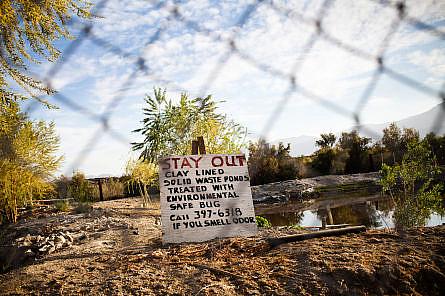Illegal trash dumping impacts Eastern Coachella Valley residents
In the first of a three-part series on what happens to our trash, KPCC's Ruxandra Guidi takes us to the Lawson Dump, located on tribal land in the small town of Mecca in the Eastern Coachella Valley. About 150 miles east of Los Angeles, the dump is home to 40 acres of garbage that rises two stories high - a toxic collection of electronic waste, household chemicals and construction debris.

There's ash, residue from nearby grape fields that have been treated with pesticides. Years ago, this pile of trash was incinerated — today, it’s still smouldering.
“That’s burning underground," says Environmental activist, Luis Olmedo, from Comite Civico del Valle, or Civic Committee of the Valley. "And you know, that stench is of chemicals? Look how creepy that looks, coming from under the ground. Who knows how deep this fire is?”
The fact that it’s still burning at all is a problem. That’s because the dump was shut down by the Environmental Protection Agency six years ago.
Outside the dump, a local resident, Alex Sanchez is visiting his mother who lives at the Duroville Trailer park that's adjacent to the mini mountain of trash. Luis asked him if he knows if the dump is still being set on fire.
"Yes, they do," says Sanchez, in his native Spanish. "Why do you think I left this mobile park? I come here every now and then to visit my mom who’s old and doesn’t want to leave. But I left about a year ago because my daughter developed really bad asthma while living here.”
The trailer park looks like a haphazard collection of old metal mobile homes, the size of studio apartments, stacked right next to one another. The federal government shut it down. But more than 100 people still call it home. There is no running water, no sewage lines. Most of the folks here are farm workers or recent arrivals from Mexico, like Eduardo Guevara and his family, who landed here when they moved from northern Mexico, five years ago. Today, he’s a community health worker.
“There are many people out here with respiratory problems," he says. "Maybe researchers can’t link it directly to the dumps, but it’s a big coincidence for a community that has been living next to a burning open-air dump for years, don’t you think?"
The fact that Lawson Dump got shut down at all makes it a unique case. Illegal dumps on tribal lands have been a growing business: there were 600 of them in 1994; now there are more than 4,000 nationally, according to the EPA. An estimated 1,000 dumps are in the Southwestern area, including Southern California.
But it's not just illegal dumps that could pose a health risk in Mecca. The Western Environmental soil recycling plant is also on tribal land. In December 2010, when almost a dozen children and teachers fell sick at a nearby school, everyone in Mecca began pointing the finger at the plant.
“Little by little I began to see the community’s problems as my own," says Guevara, explaining what it was that motivated him to become a promotor, or community health worker. "When we heard reports of people getting sick, that’s when I said: 'That's it!' The Western Environmental plant has been operating for seven years, and we have no idea what it has done to our health.”
At this point, there's no scientific evidence linking the plant to the community's health problems.
California’s Department of Toxic Substances Control just released a study that says the plant was taking in hazardous waste materials illegally, but not at high enough levels to be a threat. The study also showed the contaminated soil was coming from as far as Los Angeles, including from LA Unified School District construction sites. Neither Western Environmental nor the Cabazon Band of Mission Indians, which leases the land for the plant, would comment for this story.
Still, the locals are angry and skeptical, to say the least. They want to know exactly what impacts these trash sites are having on their health.
“One of the things I’d like to do out there, is look at the health disparities, and the health conditions out there in terms of biological indicators,” says Ryan Sinclair, a public health professor at Loma Linda University, the only academic research institution that’s beginning to study the impacts of these dumps.
But it's challenging research, given that residents in the area already suffer from very high levels of asthma, bronchitis, and skin rashes.
“We'd need to look at things in their blood, he says. "Do they have arsenic in their blood, do they have mercury? Is it at a higher percentage than the rest of the population? Once you start working out there on one problem, it’s hard to ignore the other problems.”
In the past couple of years, the locals are looking at those problems more critically, too. I drove through town with Bea Gonzalez Iñiguez, a school administrator. She's art of a new generation of Eastern Coachella Valley residents: educated, informed, and increasingly organized.
"If you take a person aside, you’d be surprised how much they know," she says. "They’re just afraid to say anything about it. And that’s the reason why we’re always being taken advantage of in this area. But that’s really changing more and more. People are really educating themselves and I don’t think they’re afraid anymore, as they used to be.”
The environmental justice movement here is just getting off the ground. Meanwhile, there is a mound of trash not far from where we're driving that's still spewing smoke.
Ruxandra Guidi’s reporting was undertaken as part of The California Endowment Health Journalism Fellowships, a program of the University of Southern California's Annenberg School for Communication & Journalism.
Article originally published on www.spcr.org.

